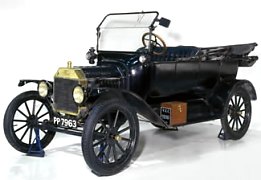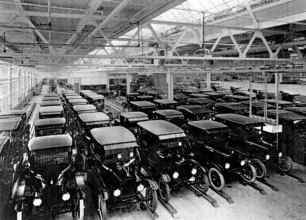 The German invented motor cars in 1880s. The French took over the lead in 1890s. But it was the American who put the world on wheels in the 1900s. A young man called Henry Ford established his motor company in 1903 and dreamed of building a motor car that everybody could afford. In those days, motor cars were very expensive because the production process was complicated and time-consuming. As a result, they were reserved for only the riches, especially playboys. The majority of people still relied on horse carriages for transportation. In the beginning, Ford produced cars in the same way as other motor car makers at the time. His first car was called Model A, then Model B, Model C... after 5 years and about 18,000 cars built, he introduced a very different car, Model T. This car was designed with low production cost in mind. Its chassis made of high-strength vanadium steel alloy was both sturdy and lightweight. Its side-valve 2.9-liter straight-4 engine had a block casted in a single piece to save production cost, unlike other cars which had individual block for each cylinder. It employed a reliable 2-speed planetary gearbox, magneto ignition, conventional transverse leaf spring suspensions, a single brake... In short, the Model T was designed to be simple, reliable and easy to build. When it went on sale in the USA, it was sold for only US$825, much lower than the $2000-$3000 level of its counterparts. Model T didn't take long to get popular. In the first full year of production, over 10,000 units were sold. This grew to 19,000 units in 1910, 35,000 units in 1911, 69,000 units in 1912, 170,000 units in 1913... Obviously, Ford hit the jackpot !   But an even greater revolution was coming. In 1914, Ford opened its new Highland Park factory with the world's first moving assembly line. Workers no longer needed to transfer the cars from here to there during the assembly process. Instead, the steadily moving assembly line transferred the cars through each station where workers carried out a simple assembly task. In this way, after a series of stations the cars were fully built. This greatly lifted efficiency, increased production capacity and lowered production cost. In prior to the move, each Model T took 12 hours to produce. Now it took only 93 minutes to leave the factory ! Ford's people consistently evaluated and improved the efficiency of assembly process. The moving assembly line became a model for the motor industry as well as a symbol of Industrial Revolution. It allowed the production to jump to 308,000 units in 1915. The larger volume translated to lower costs, thus enabled Ford to reduce the price of Model T and stimulated another wave of increased demand. Then the higher volume led to lower cost again and another price cut... this positive cycle eventually pushed its price to US$300 and annual production passed 1 million units in 1922. From 1923-25, production of Model T peaked at around 2 million units annually, which is still a record today. Model T was so popular that, by the early 1920s, it accounted for 9 out of 10 cars in the world ! No wonder it is always described as the car that "put the world on wheels". Nevertheless, its sales started to decline in 1926 as a result of lack of update. Through the years, Henry Ford concentrated more on the manufacturing process rather than improving the car itself. He insisted the simple and reliable approach and neglected the market demand for more power, style and sophisticated features. To simplify production, he offered no choice of colors except black. (He was quoted for saying "You can paint it any color, as long as it's black.") By the mid-1920s, arch-rival Chevrolet gave it increasingly heavy pressure. Ford finally replaced the Model T in 1927. After 20 years of production, some 15 million cars were built. This was only ever surpassed by Volkswagen Beetle. Model T opened the era of mass production. |